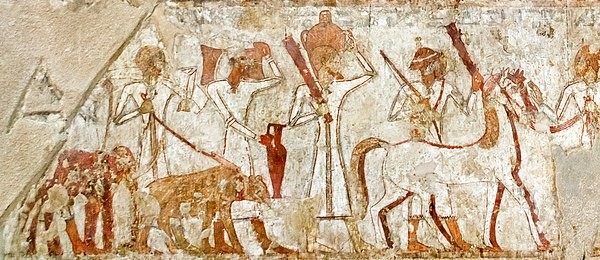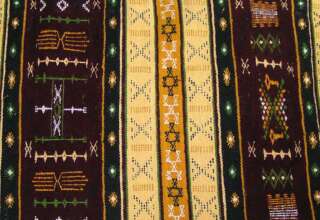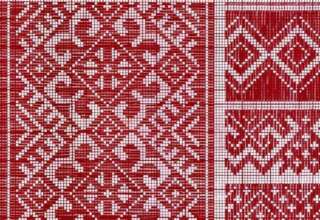
The Suez Canal
The Suez Canal, an artificial sea-level waterway, connects the Mediterranean Sea and the Red Sea, enabling direct shipping between Europe and Asia without navigating around Africa. In 2023 it generated a record $9.4 billion in revenue for Egypt.[232] Opened in November 1869, the 193.30 km (120+1⁄8 mi) canal runs from Port Said in the north to Port Tawfiq in the south, with Ismailia situated 3 kilometres (1+7⁄8 miles) west of its midpoint. The canal is 24 metres (79 feet) deep and 205 m (673 ft) wide as of 2010, consisting of a 22 km (14 mi) northern access channel, a 162.25 km (100+7⁄8 mi) main section, and a 9 km (5+1⁄2 mi) southern access channel. The Ballah By-Pass and the Great Bitter Lake provide passing points along the canal, which operates without locks, allowing seawater to flow freely.
Water supply and sanitation
Green irrigated land along the Nile amidst the desert and in the Nile Delta Egypt’s water supply is heavily dependent on the Nile River, which provides approximately 90% of the country’s total water resources, with an annual share of 55 billion cubic meters, unchanged since 1954. An additional 0.5 billion cubic meters comes from non-renewable groundwater sources. However, national demand exceeds 90 billion cubic meters annually, creating a persistent water deficit. As a result, Egypt’s per capita water share fell to 570 cubic meters in 2018, well below the 1,000 cubic meter international water scarcity threshold. To address this, the government has prioritized efficient water management, particularly in response to population growth and agricultural expansion.
Despite these challenges, water access has significantly improved. Between 1990 and 2010, piped water coverage rose from 89% to 100% in urban areas and from 39% to 93% in rural areas, eliminating open defecation in rural regions and achieving near-universal access to an improved water source. By 2015, 90% of the population had access to safely managed drinking water, increasing to 96.9% by 2019. Similarly, proper sanitation coverage expanded from 50% in 2015 to 66.2% in 2019, while the percentage of treated wastewater relative to total wastewater rose from 50% to 68.7% in the same period, reaching 74% in 2022.[237] However, gaps in sanitation infrastructure have historically led to health concerns, with a 2007 report estimating 17,000 child deaths annually from diarrheal diseases linked to poor sanitation.
Egypt has made significant investments in wastewater treatment infrastructure as part of its broader water management strategy. In 2021, the Bahr El Baqar Wastewater Treatment Plant was completed, becoming the largest in the world at the time, with a capacity of 5 million cubic meters per day. The treated water from this facility is allocated to irrigating 342,000 acres under the Sinai Peninsula Development Plan. In 2023, Egypt inaugurated the New Delta Wastewater Treatment Plant, surpassing Bahr El Baqar as the largest wastewater facility globally, with a capacity of 7.5 million cubic meters per day. A key component of Egypt’s agricultural expansion strategy, the plant supports the New Delta reclamation project while also reducing pollution in Lake Mariout and the Mediterranean Sea.[239]
Given Egypt’s arid climate and lack of appreciable rainfall, agriculture is entirely dependent on irrigation. The Nile River, regulated by the Aswan High Dam, releases an annual average of 55 billion cubic meters, of which 46 billion cubic meters are diverted into irrigation canals. This irrigation sustains 33,600 square kilometers (13,000 square miles) of agricultural land in the Nile Valley and Nile Delta, producing an average of 1.8 crops per year.






